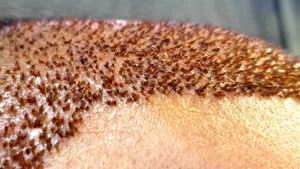After Hair Transplant Scabs are normal after a hair transplant. Those scabs develop around the grafted follicles as tiny incisions in the skin heal. Despite their alarming appearance, knowing how they’re caused and how to take care of them is the key to recovery. At HairNeva, we oversee post-surgery recovery right through the process from careful scab healing to continued free hair growth.
What Causes Post-Transplant Scabs?
Scabs after hair transplant are mainly the result of your body’s natural healing process. Small wounds are made in the scalp and tiny grafts are planted during a hair transplant. Blood and plasma pool at graft sites and scab. Common contributing factors include:
- Natural healing: Scabs shield the follicles and keep out infection.
- Bleeding in surgery: Small blood spots can become dry and form crusts.
- Dryness, or irritation: Scratching, touching, or using harsh products may aggravate scabbing.
It’s worth mentioning scabs are typically harmless and will naturally rear their ugly heads after 7 to 14 days post-transplant.
Why Scab Care Matters
Care of scabs is vital to a good result from your hair transplant. If you pick off your scabs prematurely or are too rough, you risk harming new hair follicles and hindering hair growth. At HairNeva we recommend avoid aggressive handling and using recommended shampoos and solutions for safe healing support.

Tips for Managing After Hair Transplant Scabs
- Do Not Pick or Scratch: Allow scabs to fall off on their own. You don’t want to knock out those grafts with your hand and slow down healing.
- Keep It Clean: Gently shampoo your scalp with gentle doctor recommended baby shampoo for a clean scalp that doesn’t dry out the skin.
- Use moisturizer, if necessary: A slight use of approved lotions can cut back on extreme dryness or flakiness.
- Follow Post-Operative Wound Care: Following your doctor’s recommendations on washing, medicine, and topical treatment reduces risks.
- Avoid the Sun: Keep your scalp out of direct sunlight, as UV rays can exacerbate any irritation or discoloration.
Common Concerns and Myths
A lot of patients are concerned that having a scab means they’ve had poor results or that there’s an infection. The fact is, scabs are a natural part of the healing process. I suspect the latter and think signs of infection, swelling, redness or pus are separate and should reignite your need for medical help. In HairNeva, we teach patients to determine between natural healing and that which may be problematic.
Scab Shedding and Hair Growth
Some patients experience shock loss during which some of the newly transplanted hair falls out. It’s a normal part of hair loss, and new hair usually begins to grow again within a few months. Knowing this phase can help you stay calm and patient while waiting to see full results.
HairNeva’s Approach to Post-Transplant Care
At HairNeva, our role is not just ensuring your hair will grow but we also offer full after-transplant maintenance help to get rid of scabs and guide you on the best healing. Our care plan includes:
How to wash out scabs safely step by step.
Suggested shampoos and topicals to calm the scalp.
Post treatment follow ups to assess healing and re-growth of hair.
With HairNeva, thanks to mastering the professional surgical technique and after management, no crusts appear and that hair regrowth is improved.
